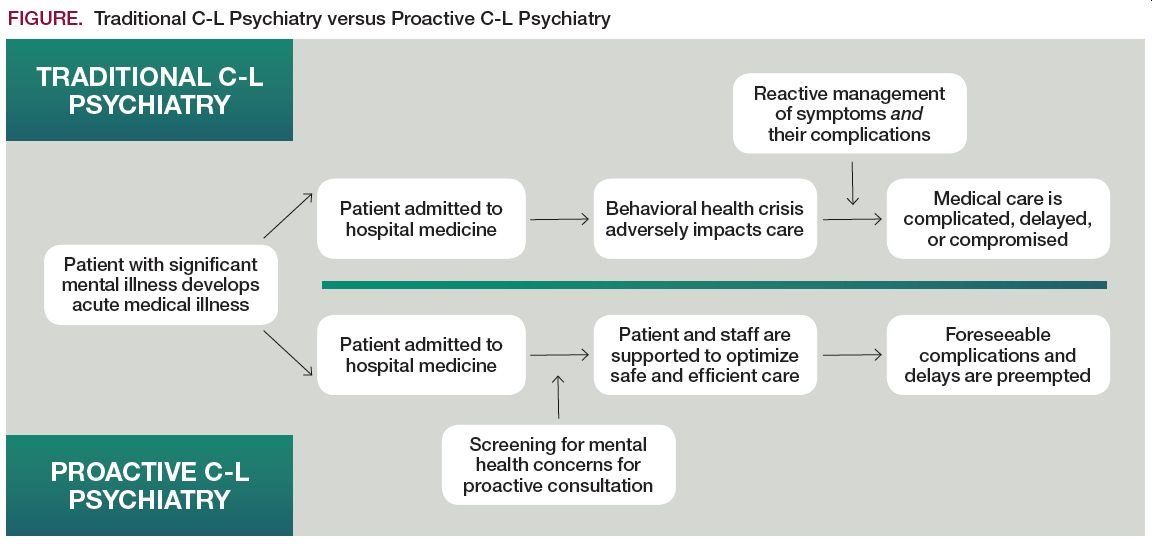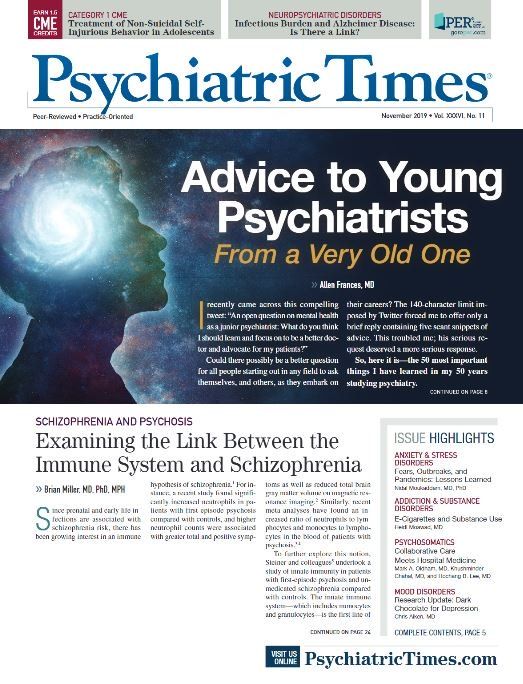Publication
Article
Psychiatric Times
Collaborative Care Meets Hospital Medicine: Proactive Consultation-Liaison Psychiatry
Author(s):
Mental illness accounts for a third of all years lived with disability and is associated with twice the relative risk of all-cause mortality. An estimated 8 million deaths are attributable to mental disorders every year, with two-thirds due to comorbid medical illness.
©WavebreakMedia/Shutterstock.com

Table. Distinctions between traditional C-L model and proactive C-L model

Figure. Traditional C-L Psychiatry versus Proactive C-L Psychiatry

Mental illness accounts for a third of all years lived with disability and is associated with twice the relative risk of all-cause mortality. It also contributes to other leading causes of death such as heart disease, cancer, and cerebrovascular disease. An estimated 8 million deaths are attributable to mental disorders every year, with two-thirds due to comorbid medical illness.
Medical and psychiatric conditions are often interdependent with complex relationships between them. Medical conditions can cause mental illness by way of psychological and/or physiological effects; mental illness may make it difficult to engage in medical care due to barriers to access, poor motivation, functional impairment, and the like; and many medical and psychiatric conditions share common psychosocial determinants (eg, adverse childhood experiences).
CASE VIGNETTE 1
A 56-year-old man with schizophrenia, hyperlipidemia, and hypertension who smokes a pack of cigarettes a day presents to the emergency department (ED) with chest pain. The diagnosis is acute coronary syndrome; he is admitted and scheduled for cardiac catheterization with possible angioplasty. On admission, blood pressure and cholesterol medications are continued. However, the primary team is unaware of his recent increase in risperidone dose from 2 mg qhs to 2 mg bid and starts him on 2 mg qhs. Nicotine replacement is not discussed.
The patient becomes distressed and increasingly paranoid about blood work and cardiac monitoring; he refuses cardiac catheterization for two days, saying, “I’ll think about it and let you know tomorrow.” On hospital day 3, he accuses his nurse of trying to poison him and refuses all medications. Agitated, he demands an against-medical-advice discharge and pushes the nurse, prompting security involvement, physical restraint, and sedation.
The medical team orders a constant companion (ie, sitter) and consults psychiatry. The patient is psychotic when evaluated by the consultation-liaison (C-L) psychiatrist the following day and found to lack capacity to refuse medical care. The patient’s cardiac enzymes normalize with medical treatment instead of cardiac catheterization while the hospital pursues temporary conservatorship. The patient waits another three days until a psychiatric hospital bed becomes available. He is in the psychiatric wing of the hospital for several days when he once again has chest pain at rest, and he is promptly transferred back to a medical wing.
CASE VIGNETTE 2
A 46-year-old woman with chronic PTSD and a general mistrust of authority figures is admitted to the hospital with hematochezia, hypotension, and concern about a lower gastrointestinal bleed. On admission, the patient is identified on chart review by a proactive C-L service because she has a major psychiatric diagnosis and a documented history of psychiatric hospitalization.
During a brief evaluation by a psychiatric social worker the morning of hospital day 2, the patient is hypervigilant and ruminates about an anticipated colonoscopy; the social worker recommends that the primary team order a psychiatric consultation. A C-L psychiatrist sees the patient that day, begins to develop rapport with the patient, and helps to establish basic principles of trauma-informed care. Feeling more comfortable with her treatment team and the outlined plan of care, the patient undergoes colonoscopy without delay or incident; she is referred for mental health aftercare for treatment of PTSD.
CASE DISCUSSION
These two cases contrast how major mental illness might be managed on a hospital medicine unit supported by traditional reactive C-L psychiatry versus by a proactive C-L model (Figure). The first case illustrates difficulties in communication and managing psychiatric illness. Ultimately, the patient’s care was compromised, the providers were exasperated, and the system incurred greater costs. The second case illustrates the potential value of meeting psychiatric needs from the time the patient arrives at the hospital. A multidisciplinary team identified patient-specific concerns and facilitated communication, which resulted in safe and efficient care.
Currently, more than a dozen sites around the country, including academic medical centers (eg, University of Rochester, Yale, University of Pennsylvania, Johns Hopkins, Northwestern) and community hospitals (eg, Sarasota Memorial Hospital), have fully established or pilot proactive C-L psychiatry services.
Care delivery in the general hospital
Psychiatric comorbidity among medicine and surgery inpatients is high, yet roughly half of these conditions go unrecognized. Based on claims data, 1 in 3 hospital patients has a psychiatric diagnosis;1 however, more than half of the patients admitted for non-psychiatric admission may have a diagnosis of mental illness.2 SimiCof hospital patients have a mentalN health concern deserving clinical attention.3 Patients with active psychiatric conditions undergo more procedures, receive more consultations of any kind, have longer durations of hospital stay, and are more likely to be discharged to a facility rather than home. They are also more likely to leave against medical advice and to have higher utilization of hospital care and other health care resources after discharge.
Although medical complexity may explain a portion of the poorer outcomes observed in patients with psychiatric comorbidity, other factors contribute as well. For example, patients with mental illness may receive substandard medical care because of a provider’s implicit bias or both patient and provider stigma associated with mental illness.
Improved care
Psychiatric comorbidity in the hospital is overlooked by primary teams more than half the time, and only one in five medical inpatients with psychiatric comorbidity is in outpatient mental health treatment at the time of acute hospital care.4 Psychiatric consultation offers several benefits including enhanced medication and psychosocial interventions. Moreover, patients may be more likely to engage in care after speaking with a psychiatric consultant, especially where psychological issues contribute to care refusal.
Psychiatric consultation can lead to shorter duration of hospital stay and consequently to financial savings. This effect may be more pronounced when consultations occur earlier during hospitalization. Consultations also facilitate outpatient mental health referrals, which may include psychiatric admission or discharge to another level of mental health care and might also reduce 30-day readmission rates.5
Team-based proactive C-L psychiatry
Proactive C-L psychiatry provides the benefits of traditional C-L psychiatry while simultaneously enriching the care (Table). At Yale New Haven Hospital, the C-L service conducted a pilot study of embedded care, which led to shorter durations of hospital stay; in this program, a psychiatrist rounded daily with a hospital medicine team and provided real-time consultation and advice.3 Subsequently, the Behavioral Intervention Team (BIT) was started as a multidisciplinary form of embedded care. This team engaged the full complement of floor staff, not just the primary medical team.6 Its goals were to identify patients with behavioral issues that could compromise medical care delivery; ensure timely psychiatric treatment; and assist with psychiatric disposition, aftercare, and sitter use.
The 11-month pilot was shown to shorten the duration of stay among patients receiving BIT care compared with patients who had received non-BIT psychiatric consultation a year earlier (6.7 days versus 7.3 days). Moreover, the mean duration of stay for all patients was statistically lower than it was the preceding year. Based on the most conservative models, the BIT service is cost-neutral, but when the cost savings attributable to shorter hospital stays and increased revenue from backfill are considered, a net cost-benefit was shown with a return on investment of nearly 2 to 1.7 BIT was also rated favorably by roughly 9 out of 10 nurses. The financial benefits and staff satisfaction led to an expansion of BIT to serve all medicine units at Yale New Haven Hospital.
As adoption of this model continues to expand, several adaptations of proactive C-L psychiatry have been initiated. A recent systematic review identified two features of proactive C-L psychiatry consistently associated with reduced duration of stay8: a screening process aided by clinical expertise in mental health care and integration of mental health providers with primary services.
Team-based proactive C-L vis-Ã -vis traditional C-L
How does team-based proactive C-L differ from traditional C-L? Team-based proactive C-L differs in three ways that derive from modern advances in outpatient mental health care: it proactively identifies patients who might benefit from psychiatric care, employs a collaborative approach, and delivers care using a multidisciplinary team. The first of these seeks to prevent a cascade effect of medical and psychosocial complications that can accumulate in patients with psychiatric disorders.9 The second incorporates insights gleaned from outpatient models of integrated mental health care (eg, as in the IMPACT trial). The third draws on the value of the medical teamwork approach.10
How does proactive C-L psychiatry identify mental health needs? Rather than providing universal consultation as in some earlier models, which yields a high false-negative rate, proactive C-L psychiatry uses a multi-step process.11
The first step aims to achieve selective prevention by identifying patients with or at increased risk of active mental health issues that may interfere with medical care.12 A team member reviews the electronic health record (EHR) of each patient newly admitted to specific units, looking for evidence of psychiatric comorbidity.
Two chart-review approaches have been implemented to date. The original strategy is to have a mental health provider (eg, psychiatric nurse practitioner, clinical social worker) review the History & Physical, Problem List, and home Medications sections, supplemented by a review of notes pertaining to prior mental health care. A recently developed strategy involves an automated EHR reporting tool to screen large numbers of patients across a health care system.2 The result of either strategy is the creation of a daily screening list.
The second step aims to achieve the indicated prevention: a team member, drawing upon their mental health expertise, screens patients on the list by discussing each patient with the patient’s nurse and with the primary care team to identify active mental health concerns. The C-L team social worker also may briefly evaluate patients in person to supplement this process.
One of the following outcomes is chosen for each patient: no change in care is recommended; curbside advice to the primary team is provided without consultation; or full psychiatric consultation is requested. The C-L team member then writes a brief screening note for each patient reviewed and documents that the patient was screened, why the screen occurred (ie, what in the chart prompted the screen), and what the result of the screen was, including any care recommendations.
Who is on a proactive C-L team? The core members of the team are a C-L psychiatrist, a psychiatric nurse practitioner, and a clinical social worker. The psychiatrist is the team leader who oversees clinical care, provides consultations and, as often required in certain jurisdictions and by hospital policies, performs capacity assessments and completes medicolegal forms (eg, involuntary psychiatric commitment). The psychiatric nurse practitioner is the team quarterback who serves as the primary contact for primary teams, triages inquiries and new consultations, performs consultations, and assists with chart reviews and screens. The psychiatric social worker-ideally one with experience in acute psychiatric settings such as inpatient psychiatry or a psychiatric emergency department-is the team coordinator and collaborates with the medical social worker and care management, commonly sees patients with the psychiatrist or psychiatric nurse practitioner, arranges psychiatric aftercare, and performs chart reviews and screens.
How is proactive C-L psychiatry integrated with medicine? The overarching element of integration with this model is that it fosters personal relationships between floor staff and C-L team members. The team-based multidisciplinary nature of this model allows for unique collaboration with corresponding providers on the medical unit: physician to physician, nurse practitioner to advanced practice providers and nursing staff, and social worker to social worker and care manager. This kind of multi-level interdisciplinary collaboration overcomes many systemic, referrer, and patient-specific barriers to accessing psychiatric care.
Looking to the future
More than a dozen US hospitals have adopted a proactive C-L model. Over the past several years, interest in piloting this model across the country has been growing across the US. We are routinely solicited for information about the model and are increasingly working with institutions who have laid the preliminary groundwork and developed business plans in preparation for launching a proactive C-L program.
Questions remain about several aspects of potential value offered by this model of care, including reduction in cost of sitters, staff turnover, and 30-day readmission rates. Likewise, we need to understand the scope of potential benefits related to patient experience and outcomes, staff satisfaction, unit-based teamwork, work-life quality of care providers, and the culture shift that embraces the interconnectedness of medical and mental health.
The ongoing HOME study in the UK is a randomized hospital-based trial currently looking at the efficacy of proactive C-L psychiatry among older adult inpatients.13 Similar trials in the US are needed and would do well to consider different age groups, hospital settings, and patient mixes.
Proactive C-L is uniquely suited to tackle the Quadruple Aim of patient care: enhancing care experience, improving population health, reducing health care costs, and improving work life of health care providers.14 This model reaches more patients and delivers a broader-base of care to patients. It also offers the promise of comprehensive vertical integration with outpatient services.
Early evidence suggests that proactive C-L psychiatry can shorten the duration of hospital stays, which more than offsets the cost of providing this enhanced care. Perhaps most immediately evident to those who have worked within this model of care, is the near-unanimous satisfaction from medical and nursing staff. Ultimately, in this era of value-based care, team-based proactive C-L psychiatry is poised to enhance the overall value to patient care in the general hospital.
Disclosures:
Dr Oldham is Assistant Professor of Psychiatry, Dr Chahal is Fellow, Consultation-Liaison Psychiatry, and Dr Lee is Professor and Chair of Psychiatry, University of Rochester Medical Center. The authors report no conflicts of interest concerning the subject matter of this article.
References:
1. Bourgeois JA, Kremen WS, Servis ME, et al. The impact of psychiatric diagnosis on length of stay in a university medical center in the managed care era. Psychosomatics. 2005;46:431-439.
2. Finn CT, Thakur D, Shea KM, et al. Electronic medical record reporting enhances proactive psychiatric consultation. Psychosomatics. 2018;59:561-566.
3. Desan PH, Zimbrean PC, Weinstein AJ, et al. Proactive psychiatric consultation services reduce length of stay for admissions to an inpatient medical team. Psychosomatics. 2011;52:513-520.
4. Hansen MS, Fink P, Frydenberg M, et al. Mental disorders among internal medical inpatients: prevalence, detection, and treatment status. J Psychosom Res. 2001;50:199-204.
5. Callaghan P, Eales S, Coates T, Bowers L. A review of research on the structure, process and outcome of liaison mental health services. J Psychiatr Ment Health Nurs. 2003;10:155-165.
6. Sledge WH, Gueorguieva R, Desan P, et al. Multidisciplinary proactive psychiatric consultation service: impact on length of stay for medical inpatients. Psychother Psychosom. 2015;84:208-216.
7. Sledge WH, Bozzo JE, White-McCullum BA, Lee HB. The cost-benefit from the perspective of the hospital of a proactive psychiatric consultation service on inpatient general medicine services. Health Econ Outcome Res. 2016;2:1-5.
8. Oldham MA, Chahal K, Lee HB. A systematic review of proactive psychiatric consultation on hospital length of stay. Gen Hosp Psychiatry. 2019;60:120-126.
9. Sells D, Sledge WH, Wieland M, et al. Cascading crises, resilience and social support within the onset and development of multiple chronic conditions. Chronic Illn. 2009;5:92-102.
10. Rosen MA, DiazGranados D, Dietz AS, et al. Teamwork in healthcare: key discoveries enabling safer, high-quality care. Am Psychol. 2018;73:433-450.
11. Desan P, Zimbrean P, Lee H, Sledge W. Proactive psychiatric consultation services for the general hospital of the future. Summergrad P, Kathol R, Eds. Integrated Care in Psychiatry: Redefining the Role of Mental Health Professionals in the Medical Setting. New York: Springer; 2014: 157-181.
12. Mrazek P, Haggerty R. Reducing Risks for Mental Disorders: Frontiers for Preventive Intervention Research. Washington, DC: National Academy Press; 1994.
13. ISRCTN Registry. The HOME Study: A Study Comparing Two Different Ways of Looking After Older People in Hospitals to See if We Can Improve How Quickly They Go Home. 2018. http://www.isrctn.com/ISRCTN86120296. Accessed October 4, 2019.
14. Bodenheimer T, Sinsky C. From triple to quadruple aim: care of the patient requires care of the provider. Ann Fam Med. 2014;12:573-576.






